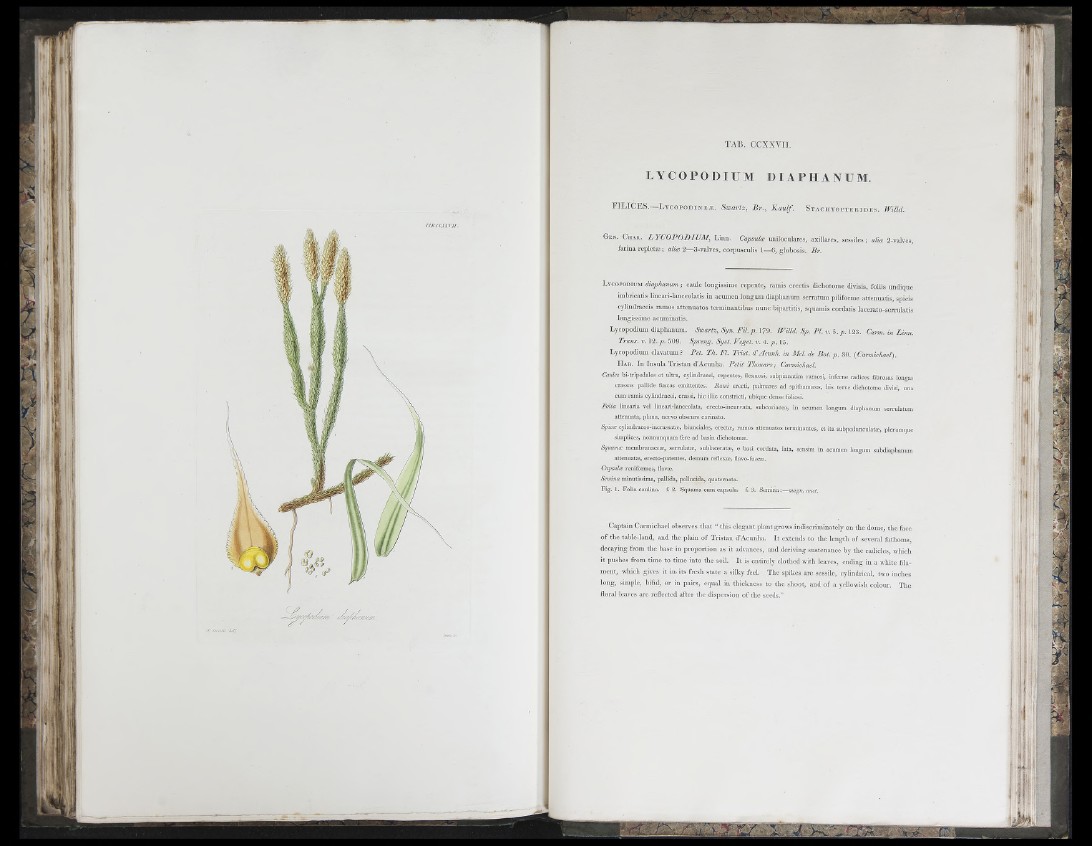
11
î ù
{■:, t
i
í li ,■
ii
« S i
L Y C O P O D I UM D I A P H A N U M .
1ILIC E S. L y c o p o d i n e æ . S w a r tz , B r ., K a u lf. S t a c h y o p t e r i d e s . Willd.
G e n . C h a r . L Y C O P O D I U M , Linn. Capsuloe u n ilo ciik r es, axillares, se ssile s; aliæ 2-valves,
farina repletæ; cÆæ 2— 3-valves, corpusculis 1— 6, g lob o sis. B r .
L y c o p o d iu m d iaphanum; caule lon g issim e repente, ramis erectis dichotome divisis, foliis undique
imbricatis lincari-lanceolatis in acumen lon gum diaphanum serratum piliformc attenuatis, spicis
cylindraccis ramos attcnuatos terminantibus nunc bipartitis, squamis cordatis lacerato-serrulatis
lon g issim e acuminatis.
L ycopodium diaphanum. S w a r tz , S yn . F il. p . 179. TFilld. S p . P I. v . 5. p . 123. Carm. in L in n .
T ra n s, v. \2 . p . 5 0 9 . S p ren g . S y s t. V eg et. v. 4. p . 15.
L ycopodium clavatum ? P e t. Th. FL T r is t. d 'Acunh. in M e l. de B o t. p . 3 0 . {C armichael).
H a i j . In Insula Tristan d’Acunha. P e tit Thouars ; Carmichael.
Caides bi-tripedales et ultra, cylindracei, repentes, flexuosi, subpinnatim ramosi, inferne radices fibrosas loiigas
crassas pallide fuscas emilteiUes. R a m i erecti, palmares ad spitbamoeos, bis terve dichotome divisi, una
cum ramis cylindracei, crassi, hic illic constricti, ubique dense foliosi.
F o lia linearía vel lineari-lanceolata, erecto-incurvata, subcoriacea, in acumen longum diaphanum serrulatum
attenuata, plana, nervo obscure cavinato.
S p icæ cylindraceo-iiicrassatæ, biunciales, erectæ, ramos attenuates termmantes, e t ita subpedunculatoe, plerumque
simplices, nonnunquam fere ad basin dichotomæ.
Squ amæ membranaceæ, serrulatoe, sublaceratoe, e basi cordala, lata, sensim in acumen longum subdiaphanum
attenuatoe, erecto-patentes, demum reflexæ, flavo-fuscæ.
Capsulæ reniformes, flavæ.
Semina minutissima, pallida, pellucida, quaternata.
Fig . 1. F o lia caldina, f . 2 . Squama cum capsula, f. 3. Sem ina :— magn.aucl.
Captain Carmichael ob.serves that “ this elegant plant g rows indiscriminately on the dome, th e face
o f the tahlc-land, and the plain o f Tristan d’Acunha. I t extends to th e len g th o f several fathoms
decaying from the base in proportion as it advances, and deriving sustenance by th e radicles, which
it pushes from tim e to time into the soil. I t is entirely clothed with leaves, ending in a white filament,
which give s it in- its fresh state a silk y feel. T he spikes arc se ssile , cylindrical, two inches
lon g , simple, bifid, or in pairs, equal in thickness to the shoot, and o f a yellowish colour. The
floral leaves arc reflected after the dispersion o f the seeds.”
'I
! § t m
: ■ I ¿ a
■!| ! A _
I I
i ■ i
If I ,
;; ^ 4 .
I